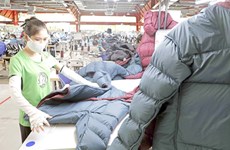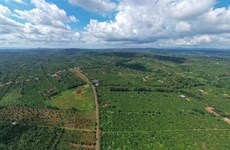Cashew sector predicted to keep stable growth
Vietnam’s cashew nuts exports in 2016 posted rapid growth, reaching 348,000 tonnes, generating a year-on-year increase of 19.1 percent in export turnover, heard a conference on January 16.
 Illustrative image (Source: VNA)
Illustrative image (Source: VNA)HCM City (VNA) –
Vietnam’s cashew nuts exports in 2016 posted rapid growth, reaching 348,000
tonnes, generating a year-on-year increase of 19.1 percent in export turnover, heard
a conference in Ho Chi Minh City on January 16.
2016 marks the 11th consecutive year Vietnam has led the world in exporting cashew nuts, accounting for 28 percent and 42 percent of the total volumes of semi-processed and processed cashew nuts, respectively, traded in the global market in the year.
However, the biggest challenge facing Vietnamese cashew processors is their dependence on imported raw cashews.
Cashew enterprises imported 1.06 million tonnes of raw cashews in 2016, the largest ever volume, up 14 percent against the previous year.
The International Nut and Dried Fruit Council forecasted that global demand for nuts in general and cashew nuts in particular will continue to stably increase with annual average growth of 10 percent as it is has been proven that the nuts are good for health.
The Vietnam Cashew Association (Vinacas) predicted that 2017 will be a favourable year for the cashew sector. However, it also mentioned difficulties that the industry is likely to face such as unfavourable weather.
Vietnam is set to export 360,000 tonnes of cashew nuts to foreign markets with a turnover of 3 billion USD in 2017, a year-on-year increase of 3.4 percent in volume and 5.6 percent in value.
At present, the US, the Netherlands and China are the largest importers of Vietnamese cashew products.
However, many businesses are concerned that the purchase power for cashew nut in the US will decrease due to a price hike expected in February this year.
Meanwhile, the cashew sector will face growing competition from Chinese businesses. Vinacas Secretary General Nguyen Hoang Giang said Chinese firms have built a number of cashew processing factories in areas bordering Vietnam.
According to Vinacas vice chairman Ta Quang Huyen, cashew nut prices reached their peak at the end of 2016 and are expected to stop or decline in 2017.-VNA
2016 marks the 11th consecutive year Vietnam has led the world in exporting cashew nuts, accounting for 28 percent and 42 percent of the total volumes of semi-processed and processed cashew nuts, respectively, traded in the global market in the year.
However, the biggest challenge facing Vietnamese cashew processors is their dependence on imported raw cashews.
Cashew enterprises imported 1.06 million tonnes of raw cashews in 2016, the largest ever volume, up 14 percent against the previous year.
The International Nut and Dried Fruit Council forecasted that global demand for nuts in general and cashew nuts in particular will continue to stably increase with annual average growth of 10 percent as it is has been proven that the nuts are good for health.
The Vietnam Cashew Association (Vinacas) predicted that 2017 will be a favourable year for the cashew sector. However, it also mentioned difficulties that the industry is likely to face such as unfavourable weather.
Vietnam is set to export 360,000 tonnes of cashew nuts to foreign markets with a turnover of 3 billion USD in 2017, a year-on-year increase of 3.4 percent in volume and 5.6 percent in value.
At present, the US, the Netherlands and China are the largest importers of Vietnamese cashew products.
However, many businesses are concerned that the purchase power for cashew nut in the US will decrease due to a price hike expected in February this year.
Meanwhile, the cashew sector will face growing competition from Chinese businesses. Vinacas Secretary General Nguyen Hoang Giang said Chinese firms have built a number of cashew processing factories in areas bordering Vietnam.
According to Vinacas vice chairman Ta Quang Huyen, cashew nut prices reached their peak at the end of 2016 and are expected to stop or decline in 2017.-VNA













